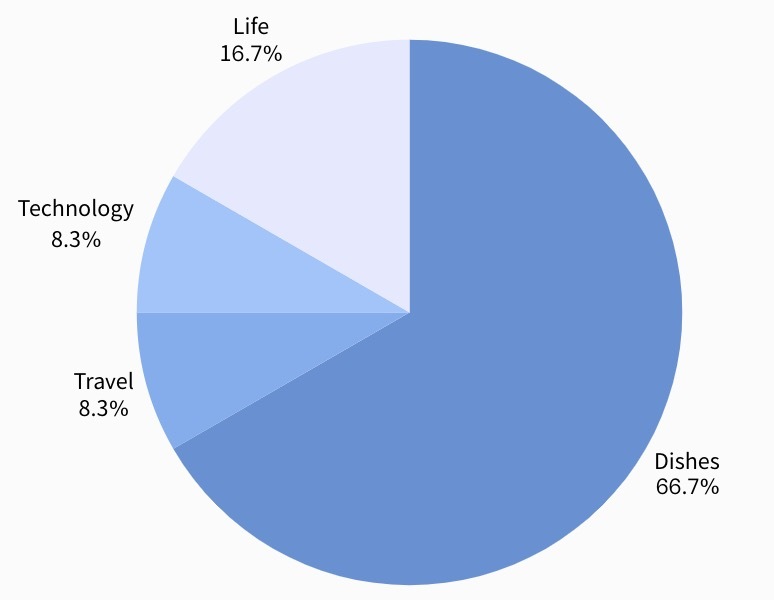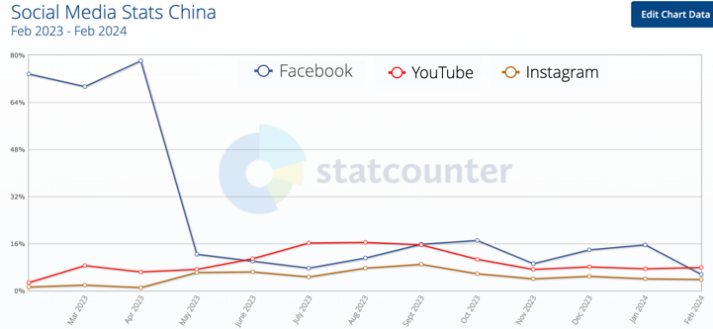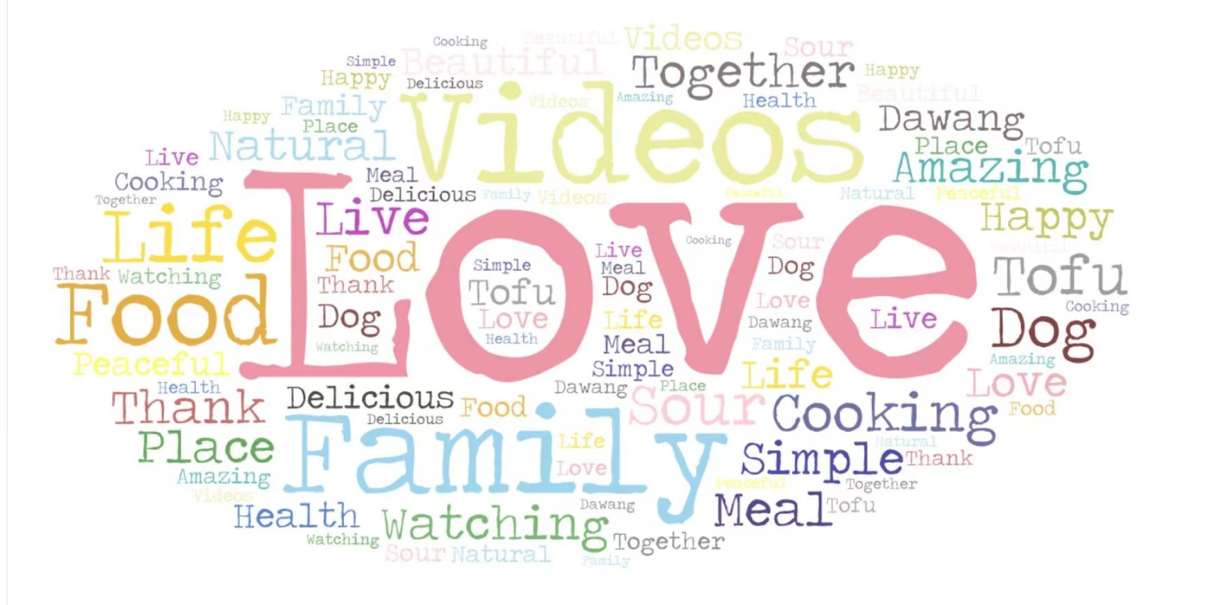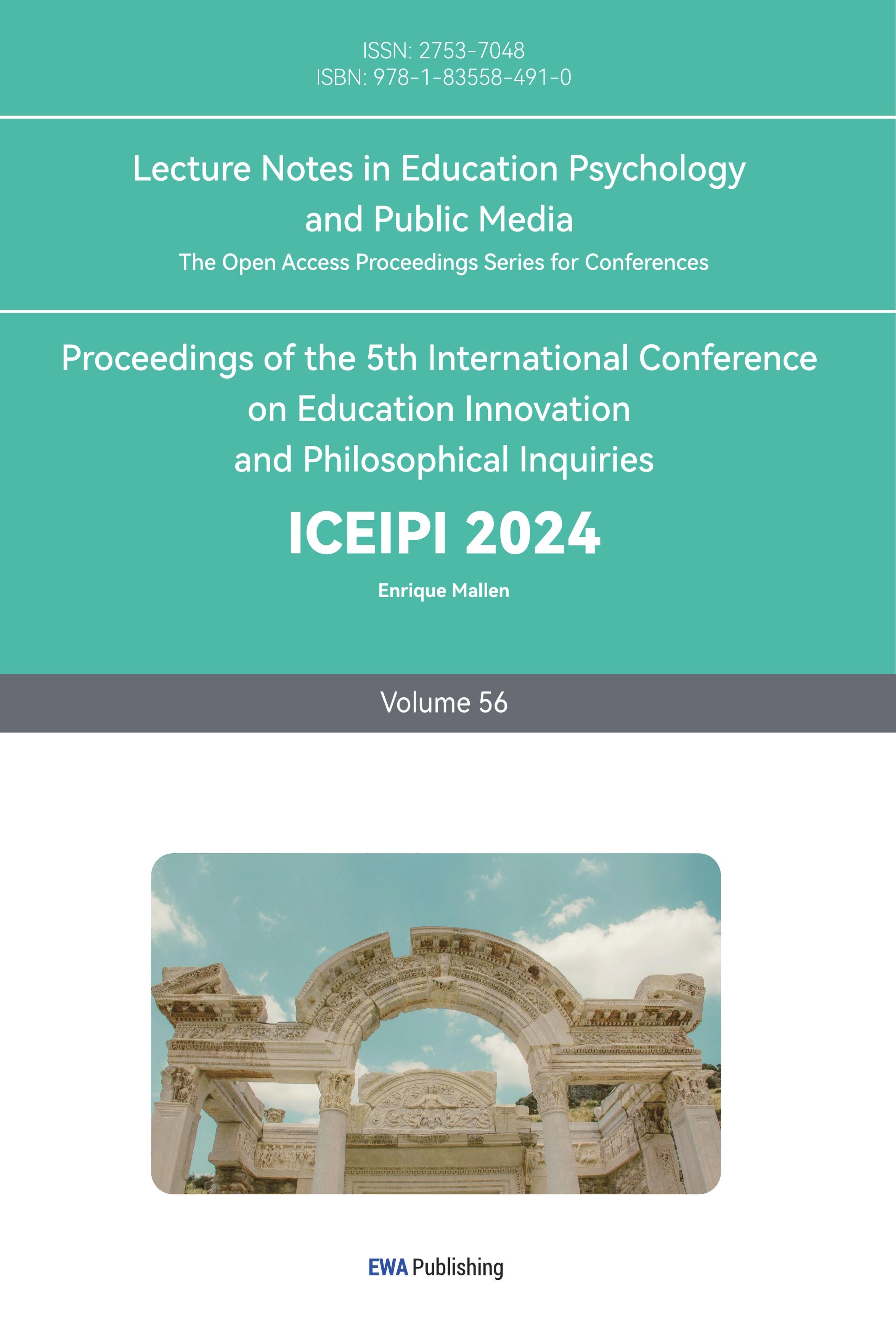1. Introduction
Food, an element closely related to human life, has been loved by people all over the world since ancient times and has become a common topic across borders. In the narrative of "we media", the spreading power of food is particularly significant. We selected 28 Chinese "We media" accounts with the most followers on YouTube as research objects. And select their most representative video authors as research samples. After screening, we found that 66.7% of the 28 samples were related to food. It includes life food, city food, travel food and so on. Not only that, according to the survey data of Pew Research, short videos about food are the third most popular among overseas users on YouTube (Figure 1).

Figure 1: Distribution of the top 28 popular blogger domains in YouTube
Food is a unique cultural symbol. We-media short videos stimulate the audience's taste and smell associations through well-composed pictures and pleasant sounds, and realize the multi-dimensional presentation of food. This way of expression effectively breaks the barrier of cross-cultural communication, so that audiences from different cultural backgrounds can resonate. Chinese we-media short video creators show the color, aroma and taste of food from multiple angles, drawing a seductive map of Chinese food for netizens, so that audiences around the world can appreciate the charm of Chinese food [1].
In the era of information globalization, short video quickly emerges with its unique charm. It skillfully integrates images, music, sound and pictures and other expression techniques, bringing users an unprecedented audio-visual feast, so it has been warmly sought after by global netizens. Among them, the short video social media represented by YouTube has become a new position of cross-cultural communication. It not only provides a broad platform for the exchange of different cultures, but also brings new challenges and opportunities for telling Chinese stories well [2]. After comparing the three major international mainstream media: YouTube, Facebook and Instagram, we found that Chinese users are more active on YouTube. We media creators such as "Li Ziqi" and "Office Ono" have accumulated tens of millions of fans on YouTube platform with their creativity and high-quality content, winning the love and recognition of audiences at home and abroad.
As you can see, the number of Chinese users on YouTube is relatively flat. It can be seen that in the long run, most Chinese users will choose to use YouTube for knowledge dissemination (Figure 2).

Figure 2: Social media statistics in China (Data from Statcounter)
These we-media creators, through the medium of short videos, show the charm of Chinese culture and the colorful life to the world, tell Chinese stories in a vivid way, and build a bridge for cross-cultural exchanges. Their successful practice not only provides a beneficial exploration for the international dissemination of Chinese culture, but also provides valuable reference and inspiration for more creators of "we-media". This paper focuses on the short videos on the topic of Chinese food culture on YouTube platform, in-depth analysis of their narrative commonalities, aiming at providing useful references for the future dissemination of short videos. At the same time, through in-depth analysis of the communication effect of Chinese we-media on YouTube platform, this paper verifies the effectiveness of its narrative characteristics and strategies. In addition, this paper also conducted a multi-dimensional analysis of user comments on sample videos, including cognition, emotion and behavioral intention, in order to comprehensively understand users' acceptance behaviors and further confirm the narrative effect of external communication. In the process of discussion, we hope to study the narrative commonality, narrative characteristics, strategy effectiveness and external narrative effect of Chinese food culture communication, and actively promote the external communication of culture.
2. Literature review
On the international social platform, food channel is a field of concern, through short videos, live broadcasts, graphic tutorials and other forms to show the rich and colorful food culture to the audience at home and abroad, not only provides people with a guide to cooking and food appreciation, but also becomes an important window for cultural exchanges. However, the current domestic research on food channels in overseas social platforms is still insufficient, mainly focusing on the following aspects:
First, from the perspective of issues related to China on international mainstream social media platforms, different platforms show obvious thematic and emotional differences in communication characteristics and effects, which provides useful references for the communication strategies of different types of issues on different platforms [3].
Second, from the external communication status of China's we-media short videos, we media short videos can use audio-visual language to directly display Chinese food culture, break the language barrier, time and space control, strengthen emotional resonance, break the language barrier and cultural barrier of Chinese culture, and realize the "soft" communication of culture [4].
The third aspect, taking the successful "going out to sea" we-media bloggers as a case study, analyzes how their individual narrative of Posting videos on overseas platforms constructs national image, and concludes that short videos are conducive to overseas audiences' cultural identity of Chinese culture. In the context of the new era, suggestions are put forward on how to make good use of the new form of short video to better tell Chinese stories and spread Chinese culture to the world [5,6].
In the fourth aspect, taking the comments of Chinese food videos on YouTube, an overseas social platform, as the research object, big data analysis techniques and methods are adopted to verify the feasibility of food channel to carry national cultural communication. Through the precise design of the strategic combination of food journey narration, visual and auditory symbols in food videos are displayed, and cultural symbols are used to raise the international audience's attention to food, people and national culture in videos, which can not only meet the national demand for "cultural communication", but also solve the pain points in current food video production [7].
This study refers to the academic circles' research on the communication status quo of Chinese self-media short videos on overseas social platforms, especially the Chinese food channel on YouTube. This paper focuses on short videos on Chinese food culture on YouTube and deeply analyzes their narrative similarities, aiming to provide useful references for the external communication of short videos in the future. At the same time, this paper also analyzes the user comments of the sample videos to comprehensively understand the user's acceptance behavior and further confirm the narrative effect of external communication.
3. Case Study 1: The influence of video publishers on the spread of Chinese food culture
The following Table 1 analysis is based on top 600 videos with “Chinese dishes” topics on YouTube.
Table 1: Sample of top 3 videos with “Chinese dishes” topics on YouTube.
Video Topic | Publisher | Likes | Comments | Followers |
Kid fried rice | Uncle Roger shorts | 10,637,455 | 39466 | 5.94M |
mukbang | Braised pork sausage | Chicken and goose | Big crab | Big lobster | songsong and ermao | FatSongsong and ThinErmao | 8,373,341 | 8853 | 8.69M |
CHINESE UNLIMITED THALI | Raipur Food | TASTE with Saurabh | Saurabh Sarkar | 4,964,587 | 7352 | 416K |
To begin with, the degree of influence of the publisher may directly affect the popularity of video published. The top 3 videos with “Chinese dishes” topics on YouTube has been analyzed based on publishers’ effects (Table 2):
Table 2: 1st place "Chinese Dishes" related Video on Youtube.
Video Topic | Kid Fried Rice |
Publisher | Uncle roger shorts |
Likes | 10,637,455 |
Publisher's Followers | 5.94 Millions |
Uncle Roger Shorts has published 153 videos, which include food tutorials from other publishers, sharing homemade food, and sharing everyday life. This publisher’s shorts’ views are around 50k to 500k; while the Chinese food video ‘Kid fried rice’ gained 10M views. This phenomenon shows how the international public is interested in Chinese foods. However, the popularity of this video might be affected by an impactful publisher and the publisher he is learning from. The footage used in the video has been taken from a publisher who has 2.72 million followers. Plus, the top three comments from the video –such as “So glad uncle Roger saw this amazing kid” – are about the collaboration between two publishers. Accordingly, the influence of publishers may give a significant help to the popularity of Chinese food related videos. In addition, introducing Chinese culture from the perspective of foreign (relative to Chinese) can more effectively break the audience's resistance to the identity of the communicator, and enhance the credibility of the international communication content, which is an effective way for the external communication of Chinese culture (Table 3).
Table 3: 2nd place "Chinese Dishes" related Video on Youtube.
Video Topic | making | praised pork sausage | Chicken and goose | Big crab | Big lobster | songs and ermao |
Publisher | FatSongsong and ThinErmao |
Likes | 8,373,341 |
Publisher's Followers | 8.69 Millions |
FatSongsong and ThinErmao are Chinese food influences. This account uses the form of mini stories and mukbang to share Chinese dishes. Therefore, audiences are able to watch mini films while gaining more information about Chinese foods. This publisher has 8.69 million followers; However, the number of 'likes' for each video is only in the range of 1k-10k. Thus, such a large following was accumulated over a long period of time. Whereas the relatively stable number of ‘likes’ shows that Chinese food in the form of "short story", even cross-language culture, can still attract more audiences to watch (Table 4).
Table 4: 3rd place "Chinese Dishes" related Video on Youtube.
Video Topic | CHINESE UNLIMITED THALI | Raipur Food | TASTE with Saurabh |
Publisher | Saurabh Sarkar |
Likes | 4,964,587 |
Publisher's Followers | 416 Thousands |
The number of 'likes' for this video is higher than the number of followers of this publisher.
Therefore, the popularity of the publisher does not have a sufficient impact on the prevalence of Chinese food culture promotion. Also, most videos from this publisher have only 1M to 20M 'views'. In contrast, Chinese traditional food videos received 202 million views, which means that the video format usually used by publishers is not able to attract viewers to a large extent. On the other hand, Chinese food videos with no change in video style can get more views and likes. Without the blessing of other factors, Chinese cuisine can still get a strong response on European and American platforms.
Other than top three videos’ analysis, 600 videos are using a common strategy: using shorts. According to statistics, top 50 popularities videos in with Chinese food topics are made by shorts. Plus, shorter videos always gain more audiences. Accordingly, fragmented information is more readily accepted. The dissemination of Chinese culture on international platforms should be dominated by short videos to achieve maximum impact.
4. Case study 2: The enlightenment of user comments on our country's further external communication strategy
A series of self-publishers such as Liziqi and Dianxi Xiaoge have become popular among overseas netizens by posting "Idyllic" content on YouTube. Overseas users also interact with the videos by posting comments after watching the short clips. These interactive symbols are an extension of the original video content, and together they will form a research sample for interpreting the international dissemination of Chinese culture [8].
To this end, we study the content of Dianxi Xiaoge's YouTube videos and the comments underneath the videos to understand the emotional tendencies and behavioral feedbacks of overseas users towards his videos promoting Chinese food culture.
The reasons for taking Dianxi Xiaoge's comments on YouTube as our study object are: First, Dianxi Xiaoge's videos on YouTube are rich in Chinese elements, which make them a suitable target for studying the effects of the international dissemination of Chinese culture. Second, Dianxi Xiaoge has a large number of subscribing fans, who interact with him through posting likes and comments, and it is analytically valuable and reasonable to extract the communication effect of the video content from the interaction samples.
Text analysis is done on the first 50 effective comments of its five food short videos with the most likes. The 25 words with the highest frequency of all comments are screened out and presented in an intuitive cloud diagram. In the word frequency cloud diagram, the more frequent they appear in the comment list, the larger the word is (Figure 3).

Figure 3: the word frequency cloud diagram of the extracted comments.
Looking at the frequency of words in Dianxi Xiaoge's comments, we can draw the following insights about international dissemination of Chinese culture:
1) The universal value of culture and emotion:
The high frequency of "love" and "family" suggests that the themes of family and love have universal values that resonate with viewers regardless of cultural background. Emphasizing these universal sentiments and values in international communication helps to bring them closer to the audience.
2)Attraction of lifestyle:
The frequent mention of words such as "simple", "natural" and "beautiful" reflects the audience's desire for the simple and natural lifestyle shown in the video of "Dianxi Xiaoge". In international communication, the display of lifestyles in different cultures, especially those with Chinese characteristics, can arouse the curiosity and interest of viewers. As a result, cultural output can be carried out more effectively
3)The international influence of food culture:
The high frequency of words such as "cooking", "food" and "delicious" indicates that food culture has strong attraction and spreading power in international communication. By showcasing unique cooking skills and cuisines, it can attract audiences with different cultural backgrounds. It can also break down barriers of cultural communication, and promote cultural exchange and understanding.
4)The importance of high-quality content:
The frequent use of terms such as "videos", "amazing" and "watching" emphasizes the key role of quality content in attracting audiences. In international communication, producing high-quality and interesting video content and then exporting it through international social platforms is the key to attracting and retaining international audiences.
5)Use of specific elements:
"Dawang" is an Alaskan that often appears in the video of "Dianxi Xiaoge", which shows that when specific cultural or regional characteristics are covered, cute animals may arouse the interest of international viewers. In international communication, exploring and highlighting certain special elements can help enhance the uniqueness and attractiveness of the content.
6) Positive emotions and positive image building:
The appearance of positive words such as "happy", "thank" and "peaceful" indicates that viewers hold positive emotional attitudes towards the content of Dianxi Xiaoge. In international communication, conveying positive and positive information helps to shape a good international image and enhance cultural soft power.
From the word frequency analysis, the following conclusions can be drawn: emphasizing the universal value of culture and emotion, displaying attractive lifestyles, exerting the international influence of gastronomy and culture, producing high-quality content, exploring special elements, and conveying positive emotions and positive images are the key elements to enhance the effectiveness of international communication.
5. Conclusion
The results of the study found that the influence of publishers on social media platforms is indeed directly related to the popularity of their videos to some extent. This finding not only reveals a subtle link between influence and video popularity, but also provides new insights into the mechanics of online communication. In addition, our research found that short videos with quality content that emphasize the universal values of culture and emotion, and convey positive emotions, perform well in international communication. These videos are often able to cross cultural and language barriers and touch people's deep emotional resonance. They have managed to capture the attention and affection of global audiences by telling authentic and moving stories, showcasing the charm of different cultures, or conveying positive values. Therefore, for creators and publishers who want to improve the effect of international communication, in addition to focusing on improving their own influence, they should also focus on creating high-quality short video content that can touch people's hearts and convey positive emotions. This can not only attract the attention and love of more viewers, but also effectively improve the communication effect and influence of the video.
The case studies have been focusing on individual videos and YouTubers. In order to gain a better result and a more scientific conclusion that could be used to represent the whole social media, more systematic researches could be done using ChatGPT or a larger model to further study into the topic, such as the audience’s emotions towards the videos. In addition, cases with less views and are less popular should also be used as comparisons to popular videos that has been studied, allowing future understanding towards the reason behind them flow distribution and to be more comprehensive.
Due to the limited international dissemination and popularity of Chinese food, many Europeans and Americans may only be exposed to a small amount of Chinese food, and it is difficult to form a comprehensive and accurate cognition. Moreover, there are similarities in ingredients, cooking techniques and tastes between Asia and countries, which may lead some Europeans and Americans to confuse Chinese cuisine with that of other Asian countries. Although such cultural misidentification will not only lead to neglect and misunderstanding of Chinese food culture, but also limit European and American people's understanding and appreciation of the diversity of Asian food culture, it may also promote the exchange and integration of Asian food culture, bring greater international attention to Chinese food culture, and thus promote cross-cultural understanding and respect. Because when foreigners confuse Chinese food with the food of other Asian countries, it may stimulate their interest in the whole Asian food culture, and when those people in European and American countries find that the "Asian food" they previously recognized is from China, they may have a stronger interest in Chinese food, and are willing to further understand and try. This increase in attention has helped to promote the spread and promotion of Chinese cuisine internationally. And when foreigners realize that their previous perceptions are biased, they may also become aware of the differences and diversity between other cultures. This understanding may correct misconceptions about other cultures in China and prompt them to be more open and tolerant towards different cultures. However, these benefits are not directly brought about by the misrecognition itself but may produce positive effects under certain conditions. Instead of seeing misidentification as a positive phenomenon, we should strive to eliminate misunderstandings and promote accurate knowledge and communication between cultures. By strengthening the international promotion and dissemination of Chinese food culture on international social platforms, we will provide accurate and comprehensive information to help foreigners better understand and appreciate the unique charm of Chinese food culture.
Authors Contribution
All the authors contributed equally and their names were listed in alphabetical order.
References
[1]. Dai Xin, Ma Yongchao, Jin Yue, Liu Li, Zhang Yi & Yang Xue.(2023). Narrative Strategies and effects of Chinese food journey on international social media: A big data analysis based on YouTube platform. Journalism and Communication Research (02),68-89+127-128.
[2]. Chu Pingru.(2021). Master's Degree in Communication Research of Short Video from Chinese self-media on Overseas Platforms (Dissertation, Beijing Jiaotong University). Master of https://link.cnki.net/doi/10.26944/d.cnki.gbfju.2021.003375doi:10.26944/d.cnki.gbfju.2021.003375.
[3]. Dang Minghui & Ji Haojie. Analysis of communication characteristics and effects of China-related issues on international mainstream social media platforms. Journal of Information, 1-8.
[4]. Jiao Yue.(2023). Cross-cultural Communication of Foreign students on Chinese Social Media from the perspective of Hall Culture Theory -- A case study of the Douyin account "Foreigner Chris". Media (10),57-60.
[5]. Whyke Thomas William, Chen Zhen Troy & Lopez Mugica Joaquin.(2022).An analysis of cultural dissemination and national image construction in Chinese influencer Li Ziqi’s vlogs and its impact on international viewer perceptions on YouTube. The Journal of Chinese Sociology (1).
[6]. Jiao Yang, Meng Mark Zhenhao & Zhang Yunzi.(2022).Constructing a virtual destination: Li Ziqi’s Chinese rural idyll on YouTube. Journal of Teaching in Travel Tourism (3),279-294.
[7]. Lu Mengjia & Ma Erwei. (2022). The Construction of National Image by Individual image Narrative in Overseas Social Media: A Case study of YouTube video bloggers. News lovers (03), 53-57. Doi: 10.16017 / j.carol carroll nki xwahz. 2022.03.016.
[8]. Yin Quan. (2022). Success Factors of Cultural Output Short Videos: Take the YouTube Video of Dianxi Xiaoge as an Example.(eds.)
Cite this article
Yang,C.;Zhao,Y.;Zheng,H.;Zhu,Z. (2024). External Communication Effect of Short Video of Chinese We-media -- Take the Topic of Chinese Food Culture on YOUTUBE as an Example . Lecture Notes in Education Psychology and Public Media,56,157-164.
Data availability
The datasets used and/or analyzed during the current study will be available from the authors upon reasonable request.
Disclaimer/Publisher's Note
The statements, opinions and data contained in all publications are solely those of the individual author(s) and contributor(s) and not of EWA Publishing and/or the editor(s). EWA Publishing and/or the editor(s) disclaim responsibility for any injury to people or property resulting from any ideas, methods, instructions or products referred to in the content.
About volume
Volume title: Proceedings of the 5th International Conference on Education Innovation and Philosophical Inquiries
© 2024 by the author(s). Licensee EWA Publishing, Oxford, UK. This article is an open access article distributed under the terms and
conditions of the Creative Commons Attribution (CC BY) license. Authors who
publish this series agree to the following terms:
1. Authors retain copyright and grant the series right of first publication with the work simultaneously licensed under a Creative Commons
Attribution License that allows others to share the work with an acknowledgment of the work's authorship and initial publication in this
series.
2. Authors are able to enter into separate, additional contractual arrangements for the non-exclusive distribution of the series's published
version of the work (e.g., post it to an institutional repository or publish it in a book), with an acknowledgment of its initial
publication in this series.
3. Authors are permitted and encouraged to post their work online (e.g., in institutional repositories or on their website) prior to and
during the submission process, as it can lead to productive exchanges, as well as earlier and greater citation of published work (See
Open access policy for details).
References
[1]. Dai Xin, Ma Yongchao, Jin Yue, Liu Li, Zhang Yi & Yang Xue.(2023). Narrative Strategies and effects of Chinese food journey on international social media: A big data analysis based on YouTube platform. Journalism and Communication Research (02),68-89+127-128.
[2]. Chu Pingru.(2021). Master's Degree in Communication Research of Short Video from Chinese self-media on Overseas Platforms (Dissertation, Beijing Jiaotong University). Master of https://link.cnki.net/doi/10.26944/d.cnki.gbfju.2021.003375doi:10.26944/d.cnki.gbfju.2021.003375.
[3]. Dang Minghui & Ji Haojie. Analysis of communication characteristics and effects of China-related issues on international mainstream social media platforms. Journal of Information, 1-8.
[4]. Jiao Yue.(2023). Cross-cultural Communication of Foreign students on Chinese Social Media from the perspective of Hall Culture Theory -- A case study of the Douyin account "Foreigner Chris". Media (10),57-60.
[5]. Whyke Thomas William, Chen Zhen Troy & Lopez Mugica Joaquin.(2022).An analysis of cultural dissemination and national image construction in Chinese influencer Li Ziqi’s vlogs and its impact on international viewer perceptions on YouTube. The Journal of Chinese Sociology (1).
[6]. Jiao Yang, Meng Mark Zhenhao & Zhang Yunzi.(2022).Constructing a virtual destination: Li Ziqi’s Chinese rural idyll on YouTube. Journal of Teaching in Travel Tourism (3),279-294.
[7]. Lu Mengjia & Ma Erwei. (2022). The Construction of National Image by Individual image Narrative in Overseas Social Media: A Case study of YouTube video bloggers. News lovers (03), 53-57. Doi: 10.16017 / j.carol carroll nki xwahz. 2022.03.016.
[8]. Yin Quan. (2022). Success Factors of Cultural Output Short Videos: Take the YouTube Video of Dianxi Xiaoge as an Example.(eds.)









